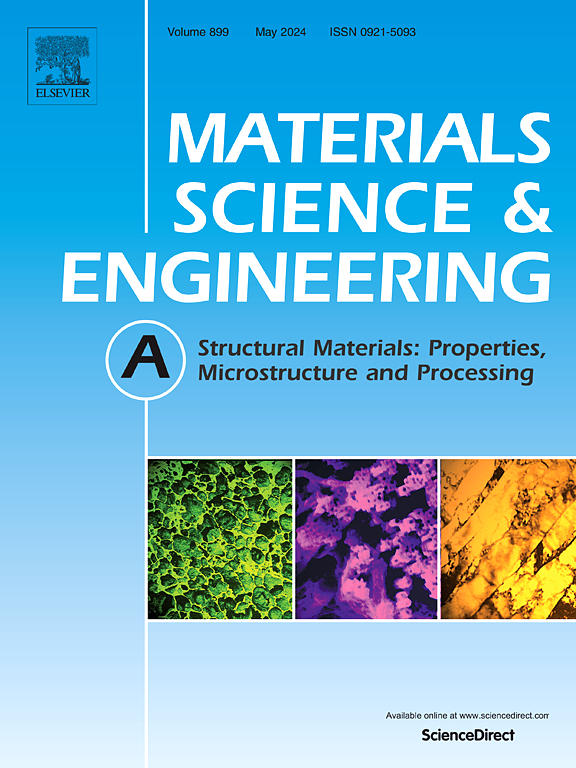Development of high-toughness high-hardness hypereutectoid steels through optimization of heat treatment and alloying elements
IF 6.1
2区 材料科学
Q1 MATERIALS SCIENCE, MULTIDISCIPLINARY
引用次数: 0
Abstract
This study designed steels based on hypereutectoid compositions containing 0.8 mass% C, 2.0 mass% Cr and 0.2 mass% Mn to achieve high toughness and hardness. The steels were subjected to two specialized heat treatments: grain boundary amelioration treatment at 810 °C and simple oil quenching process, i.e., full martensitic treatment at 950 °C. The effects of heat treatment, rolling process, and chemical composition on microstructure and toughness were investigated. Adding V formed fine vanadium carbide (VC) particles, which inhibited the coarsening of prior austenite (γ) grains, particularly in the samples subjected to full martensitic treatment. Smaller prior γ grain sizes, particularly those below 20 μm, increased impact values. Grain sizes exceeding 20 μm significantly reduced impact values. The rolling process effectively improved toughness by increasing the nucleation sites during the ferrite (α) to γ transformation in both heat treatments, refining prior γ grains, and reducing coarse carbides and inclusions. Grain boundary amelioration exhibited high impact values exceeding 100 J/cm2 at 700 HV. Notably, a maximum impact value of 243 J/cm2 was achieved in the rolled 0.7C-0.3V sample with full martensitic treatment, yielding a high hardness of 700 HV without adding expensive alloying elements. The high toughness and high hardness were simultaneously achieved by optimization of the heat treatment and chemical composition, via the control of the size and morphology of the martensitic grains. This enables selecting the best treatment for various practical applications.
通过优化热处理工艺和合金元素,研制高韧性、高硬度过共析钢
本研究设计了含有0.8质量% C, 2.0质量% Cr和0.2质量% Mn的过共析成分的钢,以获得高韧性和硬度。对钢进行了两种特殊热处理:810℃的晶界改善处理和950℃的简单油淬火工艺,即完全马氏体处理。研究了热处理、轧制工艺和化学成分对合金显微组织和韧性的影响。添加V可形成细小的碳化钒(VC)颗粒,抑制了先前奥氏体(γ)晶粒的粗化,特别是在经过完全马氏体处理的样品中。较小的γ晶粒尺寸,特别是小于20 μm的,会增加冲击值。晶粒尺寸超过20 μm显著降低了冲击值。轧制过程通过增加铁素体(α)向γ转变过程中的形核位置,细化先前的γ晶粒,减少粗碳化物和夹杂物,有效地提高了韧性。在700 HV时,晶界改善表现出超过100 J/cm2的高影响值。值得注意的是,在不添加昂贵的合金元素的情况下,在0.7C-0.3V的轧制样品中,经过全马氏体处理的最大冲击值为243 J/cm2,硬度高达700 HV。通过控制马氏体晶粒的尺寸和形貌,优化热处理工艺和化学成分,同时获得高韧性和高硬度。这样就可以为各种实际应用选择最佳的处理方法。
本文章由计算机程序翻译,如有差异,请以英文原文为准。
求助全文
约1分钟内获得全文
求助全文
来源期刊

Materials Science and Engineering: A
工程技术-材料科学:综合
CiteScore
11.50
自引率
15.60%
发文量
1811
审稿时长
31 days
期刊介绍:
Materials Science and Engineering A provides an international medium for the publication of theoretical and experimental studies related to the load-bearing capacity of materials as influenced by their basic properties, processing history, microstructure and operating environment. Appropriate submissions to Materials Science and Engineering A should include scientific and/or engineering factors which affect the microstructure - strength relationships of materials and report the changes to mechanical behavior.
 求助内容:
求助内容: 应助结果提醒方式:
应助结果提醒方式:


